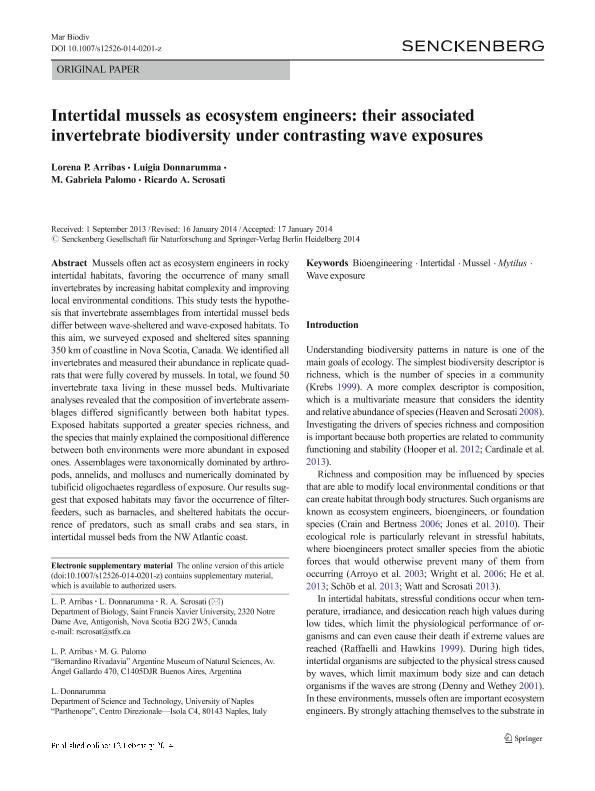Artículo
Intertidal mussels as ecosystem engineers: their associated invertebrate biodiversity under contrasting wave exposures
Fecha de publicación:
02/2014
Editorial:
Springer Berlin Heidelberg
Revista:
Marine biodiversity
ISSN:
1867-1616
e-ISSN:
1867-1624
Idioma:
Inglés
Tipo de recurso:
Artículo publicado
Clasificación temática:
Resumen
Mussels often act as ecosystem engineers in rocky intertidal habitats, favoring the occurrence of many small invertebrates by increasing habitat complexity and improving local environmental conditions. This study tests the hypothesis that invertebrate assemblages from intertidal mussel beds differ between wave-sheltered and wave-exposed habitats. To this aim, we surveyed exposed and sheltered sites spanning 350 km of coastline in Nova Scotia, Canada. We identified all invertebrates and measured their abundance in replicate quadrats that were fully covered by mussels. In total, we found 50 invertebrate taxa living in these mussel beds. Multivariate analyses revealed that the composition of invertebrate assemblages differed significantly between both habitat types. Exposed habitats supported a greater species richness, and the species that mainly explained the compositional difference between both environments were more abundant in exposed ones. Assemblages were taxonomically dominated by arthropods, annelids, and molluscs and numerically dominated by tubificid oligochaetes regardless of exposure. Our results suggest that exposed habitats may favor the occurrence of filter-feeders, such as barnacles, and sheltered habitats the occurrence of predators, such as small crabs and sea stars, in intertidal mussel beds from the NW Atlantic coast.
Palabras clave:
Bioengineering
,
Intertidal
,
Mussel
,
Wave Exposure
Archivos asociados
Licencia
Identificadores
Colecciones
Articulos(MACNBR)
Articulos de MUSEO ARG.DE CS.NAT "BERNARDINO RIVADAVIA"
Articulos de MUSEO ARG.DE CS.NAT "BERNARDINO RIVADAVIA"
Citación
Arribas, Lorena Pilar; Donnarumma, Luigia; Palomo, Maria Gabriela; Scrosati, Ricardo Augusto; Intertidal mussels as ecosystem engineers: their associated invertebrate biodiversity under contrasting wave exposures
; Springer Berlin Heidelberg; Marine biodiversity; 44; 2; 2-2014; 203-211
Compartir
Altmétricas




